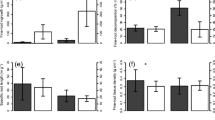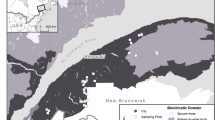Abstract
Morphology and vertical distribution patterns of spruce and beech live fine roots (diameter ≤2 mm) were studied using a soil core method in three comparable mature stands in the Solling: (1) pure beech, (2) pure spruce and (3) mixed spruce–beech. This study was aimed at determining the effects of interspecific competition on fine root structure and spatial fine root distribution of both species. A vertical stratification of beech and spruce fine root systems was found in the mixed stand due to a shift in beech fine roots from upper to lower soil layers. Moreover, compared to pure beech, a significantly higher specific root length (SRL, P<0.05) and specific surface area (SSA, P<0.05) were found for beech admixed with spruce (pure beech/mixed beech SRL 16.1–23.4 m g−1, SSA 286–367 cm2 g−1). Both indicate a flexible ‘foraging’ strategy of beech tending to increase soil exploitation and space sequestration efficiency in soil layers less occupied by competitors. Spruce, in contrast, followed a more conservative strategy keeping the shallow vertical rooting and the root morphology quite constant in both pure and mixed stands (pure spruce/mixed spruce SRL 9.6/7.7 m g−1, P>0.10; SSA 225/212 cm2 g−1, P>0.10). Symmetric competition belowground between mixed beech and spruce was observed since live fine roots of both species were under-represented compared to pure stand. However, the higher space sequestration efficiency suggests a higher competitive ability of beech belowground.



Similar content being viewed by others
References
Atkinson D (2000) Root characteristics: why and what to measure. In: Smit AL, Bengough AG, Engels C, Van Noordwijk M, Pellerin S, Van De Geijn SC (eds) Root methods: a hand book. Springer, Berlin Heidelberg New York, pp 2–32
Bauhus J, Bartsch N (1996) Fine-root growth in beech (Fagus sylvatica) forest gaps. Can J For Res 26:2153–2159
Bauhus J, Messier C (1999a) Soil exploitation strategies of fine roots in different tree species of the southern boreal forest of eastern Canada. Can J For Res 29:260–273
Bauhus J, Messier C (1999b) Evaluation of fine root length and diameter measurements obtained using RHIZO image analysis. Agron J 91:142–147
Bauhus J, Khanna PK, Menden N (2000) Aboveground and belowground interactions in mixed plantations of Eucalyptus globulus and Acacia mearnsii. Can J For Res 30:1886–1894
Beese F (ed) (2001) Indikatoren und Strategien für eine nachhaltige, multifunktionelle Waldnutzung – Fallstudie Waldlandschaft Solling. Zwischenbericht 1999/2000 zum BMBF-Verbundforschungsvorhaben, Teil 1: Gesamtbericht und Kurzfassungen. Ber. Forschungsz. Waldökosysteme Univ. Göttingen (FZW) B 63, pp 1–65
Begon ME, Harper JL, Townsend CR (1996) Ecology: individuals, populations and communities, 3rd edn. Blackwell, Oxford
Bennett JN, Andrew B, Prescott CE (2002) Vertical fine root distribution of western redcedar, western hemlock, and salal in old-growth cedar-hemlock forests on Northern Vancouver Island. Can J For Res 32: 1208–1216. DOI 10.1139/X02–034
Bloom AJ, Chapin FS, Mooney HA (1985) Resource limitation on plants – an economic analogy. Annu Rev Ecol Syst 16:363–392. DOI 10.1146/annurev.es.16.110185.002051
Böhm W (1979) Methods of studying root systems. Ecol. Stud. 33. Springer, Berlin, Heidelberg, New York
Bolte A, Hertel D, Ammer C, Schmid I, Nörr R, Kuhr M, Redde N (2003) Freilandmethoden zur Untersuchung von Baumwurzeln. Forstarchiv 74:240–262
Bolte A, Rahmann T, Kuhr M, Pogoda P, Murach D, Gadow VK (2004) Relationships between tree dimension and coarse root biomass in mixed stands of European beech (Fagus sylvatica L.) and Norway spruce (Picea abies [L.] Karst.). Plant Soil 264: 1-11. DOI 10.1023/B:PLSO.0000047777.23344.a3
Brandtberg P-O, Lundkvist H, Bengtsson J (2000) Changes in forest-floor chemistry caused by a birch admixture in Norway spruce stands. For Ecol Manage 130: 253–264. DOI 10.1016/S0378-1127(99)00183-8
Burschel P, Huss J (1997) Grundriß des Waldbaus. Parey, Berlin
Büttner V, Leuschner C (1994) Spatial and temporal patterns of fine root abundance in a mixed oak beech forest. For Ecol Manage 70: 11-21. DOI 10.1016/0378-1127(94)90071-X
Casper BB, Jackson RB (1997) Plant competition underground. Annu Rev Ecol Syst 28:545–570. DOI 10.1146/annurev.ecolsys.28.1.545
Coomes DA, Grubb PJ (2000) Impacts of root competition in forests and woodlands: a theoretical framework and review of experiments. Ecol Monogr 70(2):171–207
Curt T, Prévosto B (2003a) Root biomass and rooting profile of naturally regenerated beech in mid-elevation Scots pine woodlands. Plant Ecol 167:269–282. DOI 10.1023/A:1023904912712
Curt T, Prévosto B (2003b) Rooting strategy of naturally regenerated beech in Silver birch and Scots pine woodlands. Plant Soil 255:265–279. DOI 10.1023/A:1026132021506
Duchiron M-S (2000) Strukturierte Mischwälder: eine Herausforderung für den Waldbau unserer Zeit. Parey, Berlin
Ehwald E, Grunert F, Schulz W, Vetterlein E (1961) Zur Ökologie von Kiefern-Buchen-Mischbeständen. Arch Forstwesen 10:397–415
Ellenberg H (1996) Vegetation Mitteleuropas mit den Alpen, 5th edn. Eugen Ulmer, Stuttgart
Ellenberg H, Mayer R, Schauermann J (1986) Ökosystemforschung – Ergebnisse der Sollingprojektes. Eugen Ulmer, Stuttgart
Firbas F (1952) Spät- und nacheiszeitliche Waldgeschichte Mitteleuropas nördlich der Alpen, Bd. II: Waldgeschichte der einzelnen Landschaften. G. Fischer, Jena
Fitter AH (1987) An architectural approach to the compararive ecology of plant root systems. New Phytol 206(Suppl):61–77
Fitter AH (2002) Characteristics and functions of root systems. In: Waisel Y, Eshel A, Kafkafi U (eds) Plant roots—the hidden half, 3rd edn. Dekker, New York, pp 15–32
George E, Marschner H (1996) Nutrient and water uptake by roots of forest trees. J Plant Nutr Soil Sci 159:11–21
Göttsche D (1972) Verteilung von Feinwurzeln und Mykorrhizen im Bodenprofil eines Buchen- und Fichtenbestandes im Solling. Mitt. Bundesforschungsanst. Forst- u. Holzwirtschaft 88, Max Wiedebusch, Hamburg, pp 1–102
Grams TEE, Kozovits AR, Winkler JB, Sommerkorn M, Blaschke H, Häberle K-H, Matyssek R (2002) Quantifying competitiveness in woody plants. Plant Biol 4: 153–158. DOI 10.1055/s-2002–25729
Grime JP (1979) Plant strategies and vegetation processes. Wiley, Chichester
Hendriks CMA, Bianchi FJJA (1995) Root density and root biomass in pure and mixed forests of Douglas fir and beech. Neth J Agric Sci 43:321–331
Hertel D (1999) Das Feinwurzelsystem von Rein- und Mischbeständen der Rotbuche: Struktur, Dynamik und interspezifische Konkurrenz. Diss Bot 317, J Cramer, Berlin, pp 1–206
Horn A, Murach D (2003) Vertikale Feinwurzelverteilung und Hinweise auf interspezifische Wurzelkonkurrenz in Eschen/Buchen-Naturverjüngungen. Forstarchiv 74:46–52
Kehong Wu (2000) Fine root production and turnover and its contribution to nutrient cycling in two beech (Fagus sylvatica L.) forest ecosystems. Ber. Forschungsz. Waldökosysteme Univ. Göttingen (FZW) A 170, pp 1–130
Kelty MJ (1992) Comparative productivity of monocultures and mixed-species stands. In: Kelty MJ, Larson BC, Oliver CD (eds) The ecology and silviculture of mixed-species forests. Kluwer, Dordrecht, pp 125–141
Keyes MR, Grier CC (1981) Above- and belowground net production in 40-year-old Douglas fir stand on low and high productivity sites. Can J For Res 11:599–605
Köstler JN, Brückner E, Bibelriether H (1968) Die Wurzel der Waldbäume. Parey, Hamburg
Kramer H (1988) Waldwachstumslehre. Parey, Hamburg
Leuschner C, Hertel D, Coners H, Büttner V (2001) Root competition between beech and oak: a hypothesis. Oecologia 126: 276–284. DOI 10.1007/s004420000507
Leuschner C, Hertel, D, Schmid I, Koch O, Muhs A, Hölscher D (2004) Stand fine root biomass and fine root morphology in old-growth beech forests as a function of precipitation and soil fertility. Plant Soil 258: 43–56. DOI 10.1023/B:PLSO.0000016508.20173.80
Lorenz R L (1996) Grundbegriffe der Biometrie. G. Fischer, Stuttgart
MacQueen DR (1968) The quantitative distribution of absorbing roots of Pinus sylvestris and Fagus sylvatica in a forest succession. Oecol Plantarum 3: 83–99
Murach D (1984) Die Reaktion der Feinwurzeln von Fichten auf zunehmende Bodenversauerung. Göttinger Bodenkundl Ber 77, pp 1–127
Murach D (1991) Feinwurzelumsätze auf bodensauren Fichtenstandorten. Forstarchiv 62:12–17
Nambiar EKS, Sands R (1993) Competition for water and nutrients in forests. Can J For Res 23:1955–1968
Newton M, Cole E (1991) Root development in planted Douglas-fir under varying competitive stress. Can J For Res 21:25–31
Nielsen CCN, Mackenthun G (1991) Die horizontale Variation der Feinwurzelintensität in Waldböden in Abhängigkeit von der Bestockungsdichte. Eine rechnerische Methode zur Bestimmung der “Wurzelintensitätsglocke" an Einzelbäumen. Allg Forst- u J Ztg 162:112–119
Oberdorfer E (1992) Süddeutsche Pflanzengesellschaften. Teil IV: Wälder und Gebüsche, 2nd edn. G. Fischer, Jena
Otto H-J (1986) Standörtliche Voraussetzungen, Ziele und Waldbautechnik in Fichten-Buchen-Mischbeständen des Harzes. Allg. Forst- u. J.Ztg. 157:214–222
Otto H-J (1990) Die forstliche Entwicklung und Ziele einer naturnahen Waldpflege. Allg. Forstzeitschr 45:723–726
Otto H-J (1991) Langfristige, ökologische Waldbauplanung für die Niedersächsischen Landesforsten Bd. 2: Das niedersächsische Bergland und Gesamtauswertung. Aus dem Walde 43, pp 1–527
Otto H-J (1992) Rahmenbedingungen und Möglichkeiten zur Verwirklichung der ökologischen Waldentwicklung in den niedersächsischen Landesforsten. Forst und Holz 47:75–78
Otto H-J (1994) Waldökologie. Eugen Ulmer, Stuttgart
Parrish JAD, Bazzaz FA (1976) Underground niche separation in successional plants. Ecology 57:1281–1288
Polomski J, Kuhn N (1998) Wurzelsysteme. Haupt, Bern Stuttgart Wien
Puhe J (2003) Growth and development of the root system of Norway spruce (Picea abies) in forest stands—a review. For Ecol Manage 175: 253–273. DOI 10.1016/S0378-1127(02)00134-2
Puhe, J (1994) Die Wurzelentwicklung der Fichte (Picea abies) bei unterschiedlichen chemischen Bodenbedingungen. Ber. Forschungsz. Waldökosysteme Univ. Göttingen (FZW) A 108, pp 1–128
Rapp C (1991) Untersuchungen zum Einfluß von Kalkung und Ammoniumsulfat-Düngung auf Feinwurzeln und Ektomykorrhizen eines Buchenaltbestandes im Solling. Ber. Forschungsz. Waldökosysteme Univ. Göttingen (FZW) A 108, pp 1–293
Röhrig E, Gussone HA (1990) Waldbau auf ökologischer Grundlage, Bd. 2: Baumartenwahl, Bestandesbegründung und Bestandespflege. Parey, Hamburg Berlin
Rothe A (1997) Einfluss des Baumartenanteils auf Durchwurzelung, Wasserhaushalt, Stoffhaushalt und Zuwachsleitung eines Fichten-Buchen-Mischbestandes am Standort Höglwald. Forstl. Forschungsber. München 163, pp. 1–213
Rothe A, Binkley D (2001) Nutritional interactions in mixed species forests: a synthesis. Can J For Res 31:1855–1870. DOI 10.1139/cjfr-31-11-1855
Rust S, Savill PS (2000) The root systems of Fraxinus excelsior and Fagus sylvatica and their competitive relationships. Forestry 73(5): 499–508. DOI 10.1093/forestry/73.5.499
Rysavy T, Roloff A (1994) Ursachen der Vereschung in Mischbeständen und Vorschläge zu ihrer Vermeidung. Forst u Holz 49:392–395
Sachs L (1999) Angewandte Statistik, 9th ed. Springer, Berlin Heidelberg New York
Schmid I (2002) The influence of soil type and interspecific competition on the fine root system of Norway spruce and European beech. Basic Appl Ecol 3(4): 339–355. DOI 10.1078/1439-1791-00116
Schmid I, Kazda M (2002) Root distribution of Norway spruce in monospecific and mixed stands on different soils. For Ecol Manage 159: 37–47. DOI 10.1016/S0378-1127(01)00708-3
Schober R (1987) Ertragstafeln wichtiger Baumarten, 3rd edn. J.D. Sauerländer’s Verlag, Frankfurt/M
Schütz J-P (2001) Der Plenterwald und weitere Formen strukturierter und gemischter Wälder. Parey, Berlin
Van Praag HJ, Sougnez-Remy S, Weissen F, Carletti G (1988) Root turnover in a beech and a spruce stand of the Belgian Ardennes. Plant Soil 105: 87–103
Walter H, Breckle S-W (1991) Ökologie der Erde Bd. 1: Ökologische Grundlagen in globaler Sicht. 2nd ed. Spektrum G. Fischer, Stuttgart
Wang Z, Göttlein A, Bartonek G (2001) Effects of growing roots of Norway spruce (Picea abies [L.] Karst.] and European beech (Fagus sylvatica L.) on rhizosphere nutrient chemistry in a forest soil. J Plant Nutr Soil Sci 164:35–41. DOI 10.1002/1522-2624(200102)164:1<35
Wang Z, Göttlein A, Rodenkirchen H (2003) Soil exploration, nutrient partitioning, and nutrient efficiency of beech and spruce seedlings in a rhizotrone experiment. J Plant Nutr Soil Sci 166:390–391. DOI 10.1002/jpln.200390060
Weckesser M (2003) Die Bodenvegetation von Buchen-Fichten-Mischbeständen im Solling – Struktur, Diversität und Stoffhaushalt. Cuvillier, Göttingen
Wolff B, Erhard M, Holzhausen M, Kuhlow T (2003) Das Klima in den forstlichen Wuchsgebieten und Wuchsbezirken Deutschlands. Mitt Bundesforschungsanst Forst- u Holzwirtschaft 211, Max Wiedebusch, Hamburg, pp 1–29, 97 p (supplement)
Acknowledgements
This study was supported by the German Federal Ministry of Education, Science, Research and Technology within the cooperative project ‘Indicators and strategies of a sustainable, multi-functional forestry—case study Solling’ (BMBF FKZ 033947C/3) conducted by the Forest Ecosystem Research Centre at Göttingen University. The authors are grateful to Andreas Parth, Institute of Silviculture at Göttingen University, for his skilful help in sampling, sorting and processing the fine roots and Dr. Steffen Rust, Dresden University of Technology, Institute of Forest Botany and Forest Zoology at Tharandt and Dr. Matts Lindbladh, SLU, Southern Forest Research Centre at Alnarp (Sweden) for comments on a previous draft of the manuscript.
Author information
Authors and Affiliations
Corresponding author
Additional information
Communicated by Hans Pretzsch
Rights and permissions
About this article
Cite this article
Bolte, A., Villanueva, I. Interspecific competition impacts on the morphology and distribution of fine roots in European beech (Fagus sylvatica L.) and Norway spruce (Picea abies (L.) Karst.). Eur J Forest Res 125, 15–26 (2006). https://doi.org/10.1007/s10342-005-0075-5
Received:
Accepted:
Published:
Issue Date:
DOI: https://doi.org/10.1007/s10342-005-0075-5




